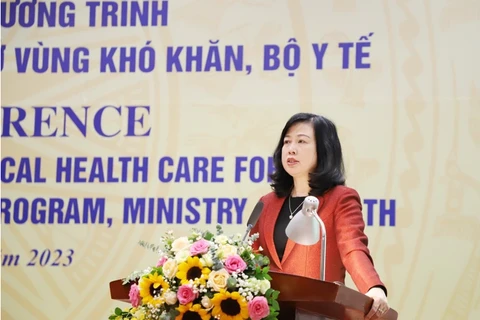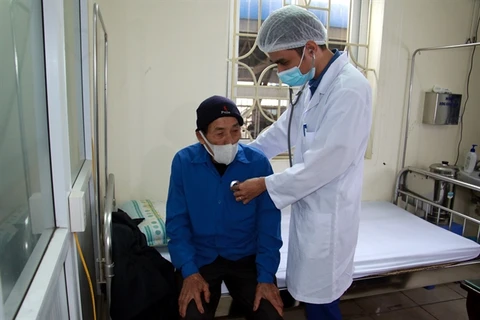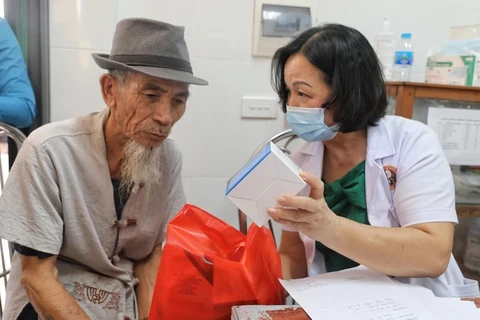Hanoi (VNA) – Vietnam’s healthcare system is facing many challenges, including changing disease patterns with the rise of non-communicable diseases, population ageing, and threats from emerging diseases.
The Prime Minister recently approved the National Strategy for protection, care and improvement of the people’s health through 2030, with a vision toward 2045, setting the target that all citizens will have access to quality healthcare services, live in a safe community, develop well physically and mentally, and contribute to improving the quality of life and that of human resources.
In an interview granted to VietnamPlus, Associate Professor Phan Le Thu Hang - Deputy Director of the Department of Financial Planning under the Ministry of Health, and Director of the Project Management Board for Construction Investment and Grassroots Health System Development - provides further details.
Challenges remain
- What are the advantages and challenges of the protection, care and improvement of people’s health now?
Associate Professor Phan Le Thu Hang: The work of protecting, caring for and improving people's health now has several favourable factors. For example, individuals, communities as well as the whole society pay more attention to health and health protection, resulting in investment increase in health care. Together with socio-economic development, the achievements of the 4th industrial revolution have effectively facilitated health care.
However, the protection, care and improvement of people's health also face significant challenges including those related to the increase in healthcare needs and expectations for the quality of medical services. Other major challenges include the changes in disease patterns with the rise of non-communicable diseases, population ageing, growing threats of emerging diseases, negative impacts of climate change and industrialisation, and the trend of increasing medical costs.
Globally, the outbreak of conflicts and wars, the occurrence with greater frequency and more serious intensity of natural disasters, economic crises, and the outbreaks of emerging diseases in recent times are clear testaments to the challenges which require every healthcare system to have a sustainable foundation (in terms of structure, human resources, technology and finance) and be flexible, creative and innovative to enhance its adaptability and resilience.
Put people at the centre
- What are the bases for developing the National Strategy for protection, care and improvement of the people’s health through 2030 to make it effectively respond to new challenges?
Associate Professor Phan Le Thu Hang: The strategy has two basic attributes - inheritance and development. The strategy was built on the inheritance of fundamental long-term orientations including equity, efficiency and progression.
New development orientations were added to meet the requirements of the protection, care and improvement of people's health in the new situation.
 Associate Professor Phan Le Thu Hang - Deputy Director of the Department of Financial Planning under the Ministry of Health, and Director of the Project Management Board for Construction Investment and Grassroots Health System Development (Photo: VietnamPlus)
Associate Professor Phan Le Thu Hang - Deputy Director of the Department of Financial Planning under the Ministry of Health, and Director of the Project Management Board for Construction Investment and Grassroots Health System Development (Photo: VietnamPlus) The strategy was developed based on five basic principles.
The first is that Vietnam’s healthcare system is developed with inherited orientations of equity, efficiency and development and some new orientations including transparency and accountability, resilience and the ability to stay sustainable and ensure the system’s flexible and effective adaptation in the new period.
In particular, the strategy identifies that the development and innovation of the health system must aim towards the desired goal of universal healthcare coverage.
The second principle to develop the strategy is that health care focuses on equity, human values, quality, and financial protection. Accordingly, healthcare activities must be based on the needs of people and must be people-centred to ensure that all people have access to quality medical services and products at reasonable costs.
Thirdly, a key approach to ensuring effective health care with a focus on equity, cost-effectiveness and safety in emergencies is “prevention is better than cure”; early action at the grassroots level; responding promptly to pandemics and health security emergencies and affirming the key role of the State in ensuring basic healthcare services.
Fourthly, regarding population work, attention must be paid to all aspects of population work including size, structure, distribution and quality of the population, golden population structure’s advantages, and challenges of population ageing. And
Fifthly, regarding healthcare responsibility, individuals, the poltical system and the entire society are responsible for protecting, caring for and improving people’s health. Particularly, the healthcare sector plays a core role. In addition, the strategy also emphasises the need to promote the role of the non-public sector in health care.
This perspective is completely consistent with the current global trend of empowering individuals and communities to optimise healthcare activities, encouraging cross-sectoral coordination and broad participation of stakeholders.
Safe community, good physical and mental development
The strategy also clearly defines the general goals to be achieved by 2030 and development directions by 2045. Accordingly, Vietnam strives to ensure that all people enjoy quality healthcare services, live in safe communities, and develop well physically and mentally, contributing to improving the quality of life and human resources for the cause of national construction and protection by 2030.
 People register for medical examination using facial recognition software at Saint Paul General Hospital in Hanoi. (Photo: VietnamPlus)
People register for medical examination using facial recognition software at Saint Paul General Hospital in Hanoi. (Photo: VietnamPlus) The strategy identifies important goals by 2045. Accordingly, Vietnam strives to build a modern, developed health system with improved service quality on par with that of developed countries in the region. The country expects to achieve universal healthcare coverage by 2045.
Priorities given to preventive medicine, grassroots health care
- To realise the strategy’s goals, what areas will be prioritised?
Associate Professor Phan Le Thu Hang: The strategy identifies several priorities for six pillars of the healthcare system.
It sets priorities in the field of health service delivery to ensure the sustainability and flexibility of all essential healthcare services such as health promotion, disease prevention, treatment, rehabilitation, and palliative care.
Notably, disease prevention and control will be strengthened, especially emerging infectious diseases, to ensure health security and promptly respond to climate change and public medical emergencies to gradually control disease risks, improve the capacity to manage the medical environment, non-communicable diseases, occupational diseases, accidents and injuries, and improve people's health.
In particular, the strategy also aims to improve the quality and efficiency of the health service supply network from the central to the grassroots level to respond to changing disease patterns and international integration and the 4.0 industrial revolution; build a strong primary healthcare system; narrow the gap in disease and mortality between regions and ethnic groups; and develop non-public health care, strengthen public-private partnership in providing health services.
In the population work, it identifies the need to firmly maintain replacement fertility levels and reduce fertility differences among regions and subjects, bring the sex ratio at birth to natural balance, take advantage of the golden population structure, adapt to population ageing and reasonable population distribution as well as improvement of population quality, and focus on health care for mothers, children, the elderly and prioritised subjects.
Regarding medical human resources, the strategy sets out priorities relating to quantity, quality and structure, especially human resources for grassroots health care, rural areas, ethnic minority areas, mountainous areas, borders, and islands to achieve a reasonable structure between doctors and nurses, and ensure a balance between training and use of medical human resources.
Regarding medical equipment, drugs, and vaccines, the strategy also emphasises the need to ensure access to and availability of qualified drugs, vaccines, biological products, supplies, and medical equipment at reasonable prices, meeting the needs of people's disease prevention and treatment. Priorities will be given to developing the domestic pharmaceutical industry, medicinal materials, and medical equipment.
Food safety control is based on risk assessment, production and business follow chains and food traceability must be promoted.
Notably, in the field of health financing, the strategy prioritises increasing the proportion of public spending on health, improving efficiency in allocating and using State budget and resources for health, and achieving universal health insurance coverage. Preventive health, grassroots health care, health care in ethnic minority and mountainous areas, borders, islands, coastal areas, and disadvantaged areas will be prioritised.
-Thank you for the interview./.

























